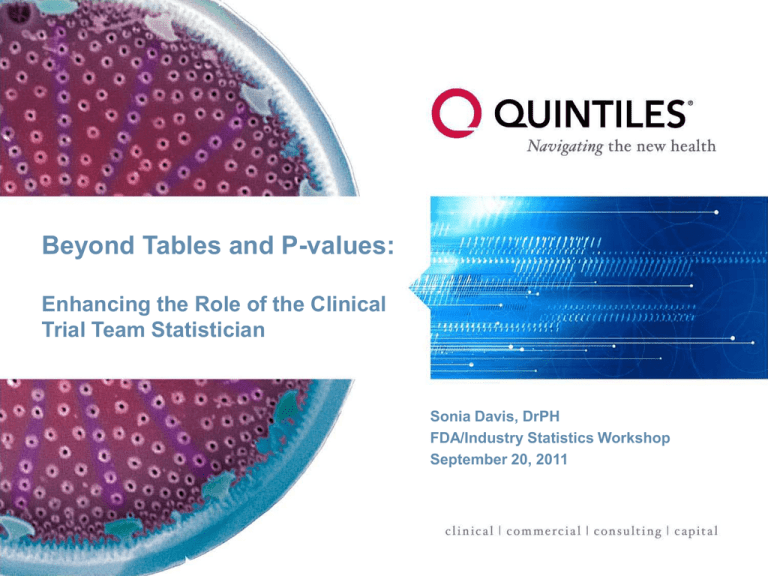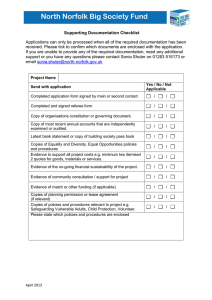Beyond tables and P-values: Enhancing the role of the
advertisement

Beyond Tables and P-values: Enhancing the Role of the Clinical Trial Team Statistician Sonia Davis, DrPH FDA/Industry Statistics Workshop September 20, 2011 The Statistician’s Role involves more than Statistics We are: Clinical Trial Scientists Statistical expertise is absolutely necessary for planning (protocol, SAP), analysis, interpretation. BUT…. There is MUCH more to a trial than planning and results. If a clinical trial is not implemented well: • Patient safety can be at risk • ‘The plan’ can be compromised • The cost and timeline can be increased Statisticians need to be involved! • To help protect the plan and reduce risks September 20, 2011 Sonia Davis FDA-Industry Workshop 2 We are uniquely positioned as problem solvers We have the needed analytical skills. We are involved in all stages of the study. Protocol Design Data Collection Analysis and Reporting Regulatory Submission …. Our teams need us! September 20, 2011 Sonia Davis FDA-Industry Workshop 3 To be effective, we must be….. Informed Engaged Proactive This presentation identifies some ways we can be. September 20, 2011 Sonia Davis FDA-Industry Workshop 4 Protocol Design Beyond statistical aspects, we should focus on: Rigor of the design to implement key steps • Point out high-risk trouble spots (LOUDLY!) • • • • • Collect quality key efficacy and safety data Randomize and dispense drug accurately Avoid unblinding Minimize bias Minimize missing data Efficiency and Simplicity of Design • Challenge our protocol development peers to minimize collection to the needed items and appropriate time points • Minimize patient burden • Minimize data entry, monitoring, cleaning, analysis, reporting (time and cost) September 20, 2011 Sonia Davis FDA-Industry Workshop 5 Implementation of Study Design This is the stage for careful thought! • Whatever can go wrong, will. Remember, in general: • Project managers, data management, IVR, CRAs do not write the protocol • Medical writers, physicians, clinical scientists do not design the systems Troubleshoot: • What could go wrong? • What design modifications could avoid/reduce the risk? Pay most attention to: • • • • Maintaining the blind Key data items High risk aspects of the design Data that can be hard to collect, record, or clean September 20, 2011 Sonia Davis FDA-Industry Workshop 6 Implementation of Study Design Database / eCRF / ePRO / Diary Design • • • • • Does design support efficient and high quality entry? Efficient format for statistical analysis? Is anything collected that is not needed/required? Remove it! Is anything NOT collected that should be? Is project consistent with related projects? Data Management Edit Checks • Be sure problem areas and key data are fully covered. • Is ancillary data being over-reviewed? Site Monitoring Plan • Less than 100% source doc verification? • Statisticians can provide input to help ensure: – Important items are all checked – Less important items are not as rigorously checked September 20, 2011 Sonia Davis FDA-Industry Workshop 7 Implementation of Study Design IVR Randomization and Drug Dispensing System • Consider risks to: – Unblinding – Patients misdosed, misrandomized • IVR entry for randomization versus eCRF data collection Labs and Other Vendors • Watch for transfer of potentially unblinding data • Be sure timing and format of transfer meets analysis needs Statisticians may not receive vendor documents. • We should proactively request to see them – To provide a statistical review – For our own better knowledge of data collection and transfer September 20, 2011 Sonia Davis FDA-Industry Workshop 8 CRA Training Statisticians should present at CRA Training Goal is to share key data items and key trouble or high risk spots with the rest of the project team PMs, data management are also at CRA training • They get the training too! How it works: • • • • Statistician presents at first CRA training Only takes about 15 minutes PM or CTL gives training on behalf of statistician at all further sessions Training could also be adapted for Investigator’s meeting September 20, 2011 Sonia Davis FDA-Industry Workshop 9 CRA Training - Content Primary Outcome Data: • Identify items that are most important – Primary and key secondary – Covariates for primary statistical analysis • Identify time points that are most important Safety Data: • Identify items with the biggest impact on our analysis – Date of randomization, date of first dose, date discontinued – AE start dates, consistency of AEs and reason for discontinuation – If an AE is serious or not – Other key dates or data items specific to study design stages Data we need for patients who discontinue very early • Did they take a first dose? September 20, 2011 Sonia Davis FDA-Industry Workshop 10 CRA Training - Content Randomization and Treatment Allocation • • • • Once randomized, always randomized Key IVR inputs needed, and how they are used by IVR Risks to patient and/or study if not implemented correctly What to do (or not to do) if something goes wrong Complex Design Components • Important “high risk” areas in the design • Ways to minimize risks of mistakes, unblinding, bias, low data quality Timing and data requirements for Mid-study Analyses • DMCs, interim analyses, early database freezes or cuts – Timing of Analyses – Level of data entry/cleanliness needed at these times September 20, 2011 Sonia Davis FDA-Industry Workshop 11 Investigators Meeting Statistician should attend Investigator’s Meeting • Both Pharma and CRO statisticians • CRO statistician attendance rarely included in budget - shortsighted So we can learn firsthand: • Disease and treatment background • Protocol Design (if we were not involved) • How assessments are measured – What is collected – How it should be interpreted • Vendor data collection and flow (IVR, Diaries / ePROs, labs, ECGs) When we know this: • The data are not “just numbers” to us • We can do a better job troubleshooting AND analyzing September 20, 2011 Sonia Davis FDA-Industry Workshop 12 Early Data Review Early data review by the statistician can provide timely feedback to project teams • Early identification of high risk areas • Early identification of site training issues or trouble sites • Early detection of possible fraud September 20, 2011 Sonia Davis FDA-Industry Workshop 13 DMC Unblinded Statistician Most often a 3rd party statistician supporting the DMC Role is to generate report, assist the DMC • Answer questions, reply to queries Unblinded statistician role should be active not passive • Help with interpretation (interim analysis, SAEs) • Point out data trends, if needed • Make suggestions in response to data requests The DMC makes the decisions • We do not provide an opinion • But, our responsibility is to ensure they have everything they need to make their decision. September 20, 2011 Sonia Davis FDA-Industry Workshop 14 Communicate Proactively Statisticians should proactively seek out other team leaders to share our ideas and troubleshoot. • Don’t wait for them to ask you Train the PM • PMs do not always understand functions performed by each group, yet they lead the team • Important to ensure PM understands how statisticians can help CRO Statisticians: • Proactively communicate with your Pharma counterpart • Ask questions, make suggestions Pharma Statisticians working with CROs: • Consider your CRO statistician a collaborator • Keep them informed, empowered September 20, 2011 Sonia Davis FDA-Industry Workshop 15 And in the End… Proactive use of analytical skills in planning can help: Avoid messy situations September 20, 2011 and Provide good data for statistical analysis Sonia Davis FDA-Industry Workshop 16

